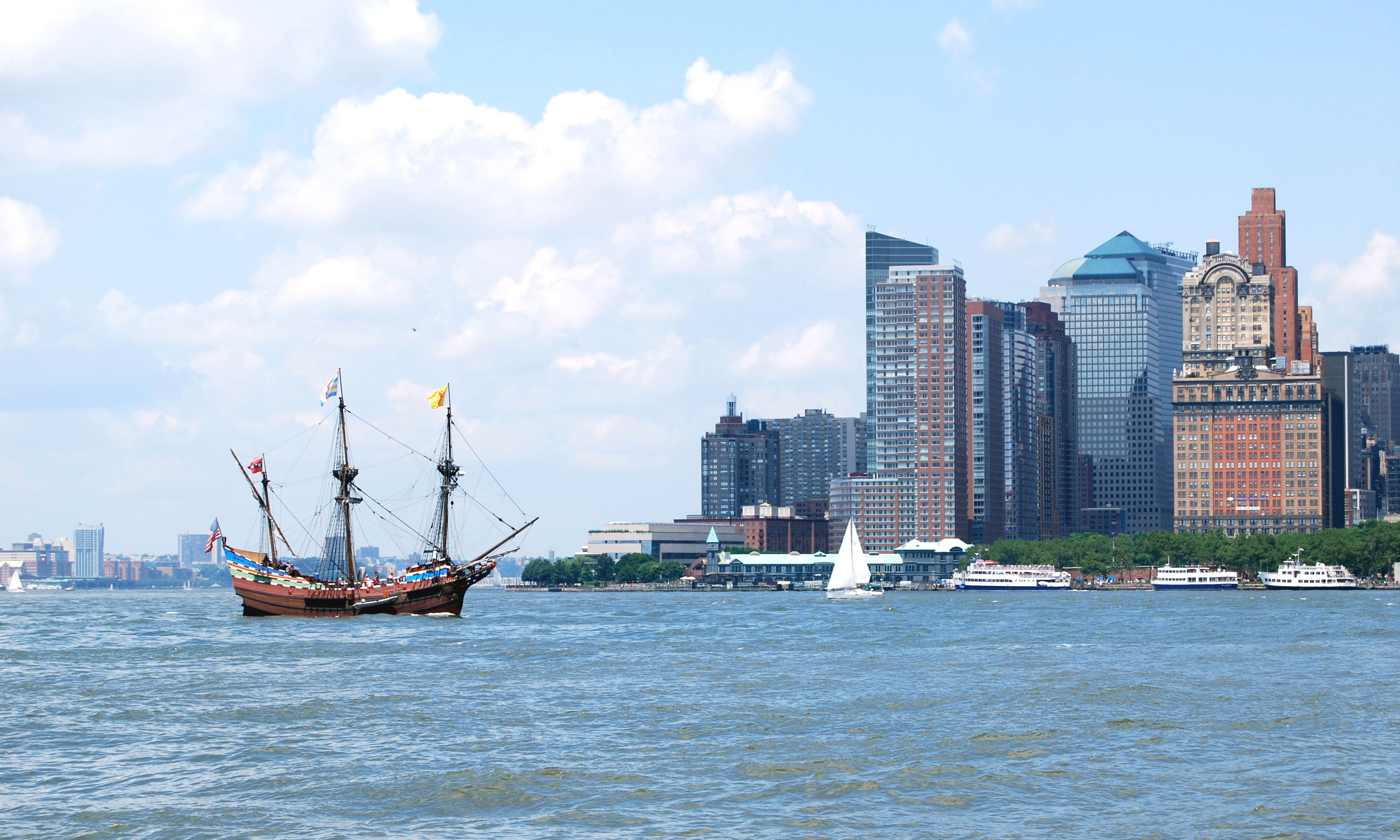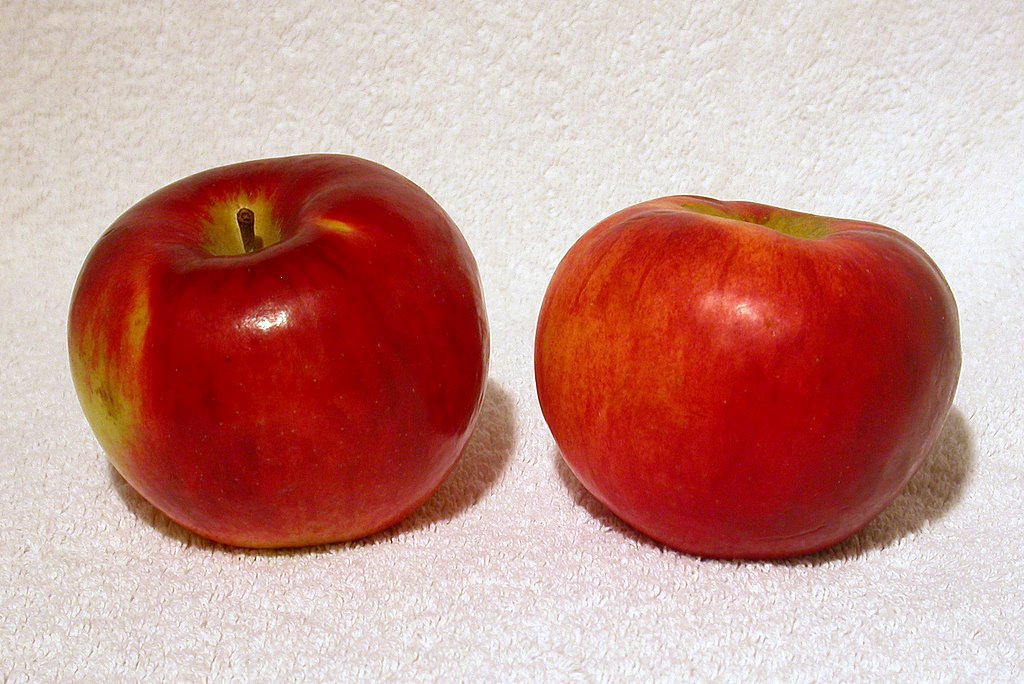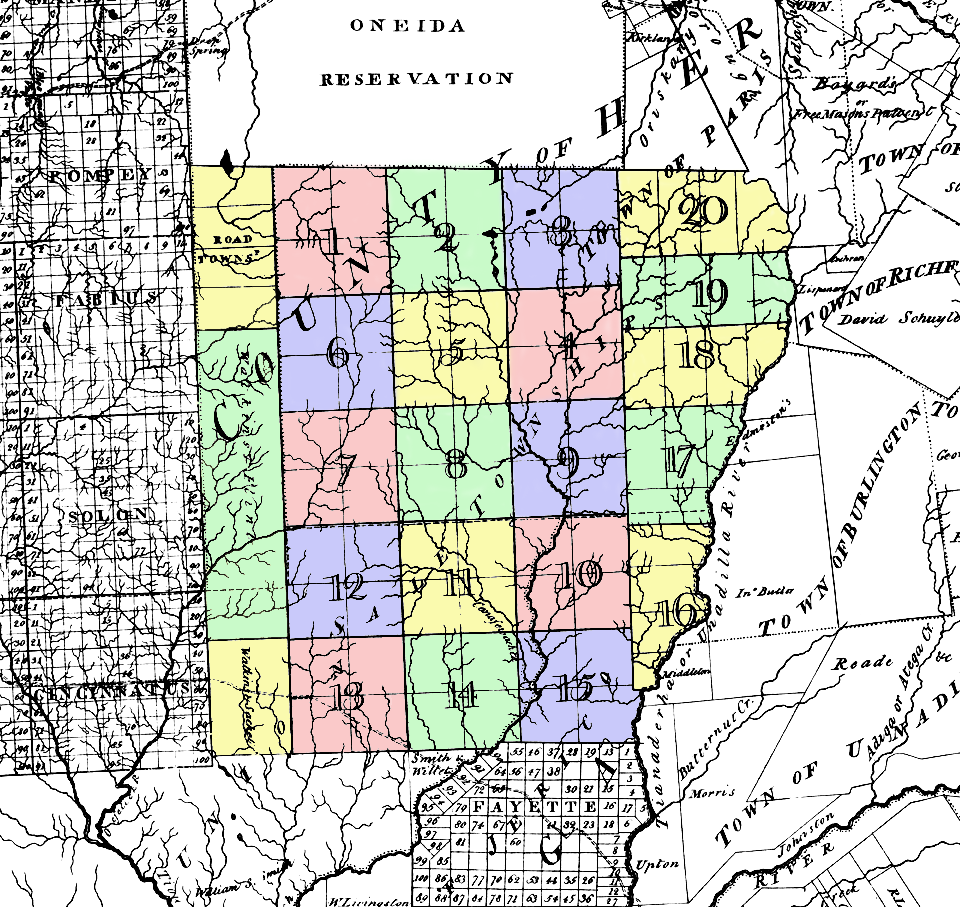|
New York State Historic Markers
New York State Markers was a state historic marker program. This was managed by the Education Department's State History office from 1926 to 1966. There are an estimated 2,800 historic markers around the state. The markers tell about historic events and locations and provide the public with knowledge about the state of New York. It is no longer a requirement to have a new marker approved by the Education Department and SED as long as they are located on private property. Historic Markers have become a major way to inform the public and tourists of local history. First created to commemorate the American Revolution the markers were loved by the public and deemed a success. Although no longer funded by the State, markers are still being installed throughout New York State today by individuals, town and county governments, and historical organizations. The Walton East Branch Foundry (one of the companies that casts the markers) reports creating up to 100 markers per year. Histor ... [...More Info...] [...Related Items...] OR: [Wikipedia] [Google] [Baidu] |
New York (state)
New York, officially the State of New York, is a state in the Northeastern United States. It is often called New York State to distinguish it from its largest city, New York City. With a total area of , New York is the 27th-largest U.S. state by area. With 20.2 million people, it is the fourth-most-populous state in the United States as of 2021, with approximately 44% living in New York City, including 25% of the state's population within Brooklyn and Queens, and another 15% on the remainder of Long Island, the most populous island in the United States. The state is bordered by New Jersey and Pennsylvania to the south, and Connecticut, Massachusetts, and Vermont to the east; it has a maritime border with Rhode Island, east of Long Island, as well as an international border with the Canadian provinces of Quebec to the north and Ontario to the northwest. New York City (NYC) is the most populous city in the United States, and around two-thirds of the state's popul ... [...More Info...] [...Related Items...] OR: [Wikipedia] [Google] [Baidu] |
Historic Marker
A commemorative plaque, or simply plaque, or in other places referred to as a historical marker, historic marker, or historic plaque, is a plate of metal, ceramic, stone, wood, or other material, typically attached to a wall, stone, or other vertical surface, and bearing text or an image in relief, or both, to commemorate one or more persons, an event, a former use of the place, or some other thing. Many modern plaques and markers are used to associate the location where the plaque or marker is installed with the person, event, or item commemorated as a place worthy of visit. A monumental plaque or tablet commemorating a deceased person or persons, can be a simple form of church monument. Most modern plaques affixed in this way are commemorative of something, but this is not always the case, and there are purely religious plaques, or those signifying ownership or affiliation of some sort. A plaquette is a small plaque, but in English, unlike many European languages, the term is ... [...More Info...] [...Related Items...] OR: [Wikipedia] [Google] [Baidu] |
American Revolution
The American Revolution was an ideological and political revolution that occurred in British America between 1765 and 1791. The Americans in the Thirteen Colonies formed independent states that defeated the British in the American Revolutionary War (1775–1783), gaining independence from the British Crown and establishing the United States of America as the first nation-state founded on Enlightenment principles of liberal democracy. American colonists objected to being taxed by the Parliament of Great Britain, a body in which they had no direct representation. Before the 1760s, Britain's American colonies had enjoyed a high level of autonomy in their internal affairs, which were locally governed by colonial legislatures. During the 1760s, however, the British Parliament passed a number of acts that were intended to bring the American colonies under more direct rule from the British metropole and increasingly intertwine the economies of the colonies with those of Brit ... [...More Info...] [...Related Items...] OR: [Wikipedia] [Google] [Baidu] |
New York State Education Department
The New York State Education Department (NYSED) is the department of the New York state government responsible for the supervision for all public schools in New York and all standardized testing, as well as the production and administration of state tests and Regents Examinations. In addition, the State Education Department oversees higher education, cultural institutions such as museums and libraries, vocational rehabilitation, and the licensing of numerous professions. It is headed by the Board of Regents of the University of the State of New York (USNY) and administered by the Commissioner of Education. Its regulations are compiled ititle 8of the ''New York Codes, Rules and Regulations''. The main offices of the department are housed in the New York State Department of Education Building, located at 89 Washington Avenue in Albany, the state capital. Each year New York spends over $22,000 per student, which is 90% more than the average in the US. Learning standards The g ... [...More Info...] [...Related Items...] OR: [Wikipedia] [Google] [Baidu] |
History Of New York (state)
The history of New York begins around 10,000 B.C. when the first people arrived. By 1100 A.D. two main cultures had become dominant as the Iroquoian and Algonquian developed. European discovery of New York was led by the Italian Giovanni da Verrazzano in 1524 followed by the first land claim in 1609 by the Dutch. As part of New Netherland, the colony was important in the fur trade and eventually became an agricultural resource thanks to the patroon system. In 1626 the Dutch thought they had bought the island of Manhattan from Native Americans. In 1664, England renamed the colony New York, after the Duke of York and Albany, brother of King Charles II. New York City gained prominence in the 18th century as a major trading port in the Thirteen Colonies. New York played a pivotal role during the American Revolution and subsequent war. The Stamp Act Congress in 1765 brought together representatives from across the Thirteen Colonies to form a unified response to British policie ... [...More Info...] [...Related Items...] OR: [Wikipedia] [Google] [Baidu] |
Onondaga County
Onondaga County ( ) is a county in the U.S. state of New York. As of the 2020 census, the population was 476,516. The county seat is Syracuse. Onondaga County is the core of the Syracuse, NY MSA. History The name ''Onondaga'' derives from the name of the Native American tribe who lived in this area at the time of European contact, one of the original Five Nations of the ''Haudenosaunee''. They called themselves (autonym) ''Onoda'gega'', sometimes spelled ''Onontakeka.'' The word means "People of the Hills." Sometimes the term was ''Onondagaono'' ("The People of the Hills"). The federally recognized Onondaga Nation has a reservation within the county, on which they have self-government. When counties were established in New York in 1683, the present Onondaga County was part of Albany County. This enormous county included the northern part of New York State as well as all of the present State of Vermont and, in theory, extended westward to the Pacific Ocean. It was reduc ... [...More Info...] [...Related Items...] OR: [Wikipedia] [Google] [Baidu] |
Cayuga County
Cayuga County is a county in the U.S. state of New York. As of the 2020 census, the population was 76,248. Its county seat and largest city is Auburn. The county was named for the Cayuga people, one of the Indian tribes in the Iroquois Confederation. Cayuga County comprises the Auburn, NY Micropolitan Statistical Area, which is also included in the Syracuse-Auburn, NY Combined Statistical Area. History When counties were established in the Province of New York in 1683, the present Cayuga County was part of Albany County. This was an enormous county, including the northern part of the present state of New York and all of the present state of Vermont and, in theory, extending westward to the Pacific Ocean. This county was reduced in size on July 3, 1766, by the creation of Cumberland County, and further on March 16, 1770, by the creation of Gloucester County, both containing territory now in Vermont. On March 12, 1772, what was left of Albany County was split into three parts ... [...More Info...] [...Related Items...] OR: [Wikipedia] [Google] [Baidu] |
Cortland County
Cortland County is a County (United States), county located in the U.S. state of New York (state), New York. As of the 2020 United States census, 2020 census, the population of Cortland County was 46,809. The county seat is Cortland, New York, Cortland. The county is named after Pierre Van Cortlandt, president of the convention at Kingston, New York, Kingston that wrote the first New York State Constitution in 1777, and first lieutenant governor of the state. Cortland County comprises the Cortland, NY Micropolitan Statistical Area, which is also included in the Ithaca, New York, Ithaca-Cortland, NY Combined Statistical Area. The Cortland (apple), Cortland apple is named for the county. History Early history Located in the glaciated Appalachian Plateau area of Central New York, midway between Syracuse, New York, Syracuse and Binghamton, this predominantly rural county is the southeastern gateway to the Finger Lakes Region. Scattered archaeological evidence indicates the Iroquoi ... [...More Info...] [...Related Items...] OR: [Wikipedia] [Google] [Baidu] |
Madison County, New York
Madison County is a county located in the U.S. state of New York. As of the 2020 census, the population was 68,016. Its county seat is Wampsville. The county is named after James Madison, the fourth president of the United States, and was first formed in 1806. Madison County is part of the Syracuse metropolitan area. History Indigenous peoples had occupied areas around Oneida Lake for thousands of years. The historic Oneida Nation is an Iroquoian-speaking people who emerged as a culture in this area about the fourteenth century and dominated the territory. They are one of the Five Nations who originally comprised the Iroquois Confederacy or ''Haudenosaunee''. English colonists established counties in eastern present-day New York State in 1683; at the time, the territory of the present Madison County was considered part of Albany County, with the city of Albany located on the Hudson River. This was an enormous county, including the northern part of New York State around ... [...More Info...] [...Related Items...] OR: [Wikipedia] [Google] [Baidu] |
Oswego County
Oswego County is a county in the U.S. state of New York. As of the 2020 census, the population was 117,525. The county seat is Oswego. The county name is from a Mohawk-language word meaning "the pouring out place", referring to the point at which the Oswego River feeds into Lake Ontario at the northern edge of the county in the city of Oswego. Oswego County is part of the Syracuse, NY Metropolitan Statistical Area. History When counties were established in the British colony of New York in 1683, the present Oswego County was part of Albany County. This was an enormous county, including the northern part of what is now New York state as well as all of the present state of Vermont and, in theory, extending westward to the Pacific Ocean. This county was reduced in size on July 3, 1766, by the creation of Cumberland County in the British colony, and further on March 16, 1770, by the creation of Gloucester County, both containing territory now in Vermont. On March 12, 1772, ... [...More Info...] [...Related Items...] OR: [Wikipedia] [Google] [Baidu] |
Erie County, New York
Erie County is a county along the shore of Lake Erie in western New York State. As of the 2020 census, the population was 954,236. The county seat is Buffalo, which makes up about 28% of the county's population. Both the county and Lake Erie were named for the regional Iroquoian language-speaking Erie tribe of Native Americans, who lived in the area before 1654. They were later pushed out by the more powerful Iroquoian nations tribes. Erie County, along with its northern neighbor Niagara County, makes up the Buffalo-Niagara Falls metropolitan area, the second largest in New York State behind New York City. The county's southern part is known as the Southtowns. The county has seen one of the highest growth rates of any county in New York State from the 2010 to 2020 census. History When counties were established by the English colonial government in the Province of New York in 1683, present-day Erie County was part of Indian territory occupied by Iroquoian-speaking peoples. It ... [...More Info...] [...Related Items...] OR: [Wikipedia] [Google] [Baidu] |
Genesee County, New York
Genesee County is a county in the U.S. state of New York. As of the 2020 census, the population was 58,388. Its county seat is Batavia. Its name is from Seneca word Gen-nis'-hee-yo, meaning "the Beautiful Valley".THE AMERICAN REVIEW; A WHIG JOURNAL DEVOTED TO POLITICS, LITERATURE, ART AND SCIENCE. VOL. VI NEW-YORK: GEORGE H. COLTON, 118 NASSAU STREET, Published 1847, Wiley and Putnam, p. 62/ref> The county was created in 1802 and organized in 1803. Genesee County comprises the Batavia, NY micropolitan statistical area, which is also in the Rochester-Batavia- Seneca Falls, NY combined statistical area. It is in Western New York. It is the namesake of Genesee County, Michigan. History Pre-Columbian era The archaeological record at the Hiscock Site, in Byron, New York goes back 10,000 to 12,000 years to the Ice Age. Researchers have found a variety of manmade tools, ceramics, metal, and leather, along with a mastodon jaw, tusks, and teeth, and assorted animal bones, indicating ... [...More Info...] [...Related Items...] OR: [Wikipedia] [Google] [Baidu] |




